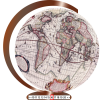The Concept
We propose an interactive globe that produces information about a region of land when physically touched by the user. The touch and interaction has visualized outputs on the globe’s surface and enables coincidence of input/output. The variety of interaction methods are summarized in the table below. We believe this tool would be useful in education. Our subjects are middle school and high school students. The object of our system is to create a fun, intuitive learning opportunity to promote political knowledge of the world we live in.
Our novel TUI is an enhancement of previous iterations of tangible globes (e.g. 4D globe, Intelliglobe, V-Tech Globe, Globus, and Exploratorium) because it further embodies physical interactions on the globe. Previous tangible globes are limited because they do not allow for spontaneity and only limited simultaneous interaction on the globe. In addition, the previous globes do not support multi touch or collaboration. The other globes either use a pen or a magnifying glass to handle user input.
Our globe enables spontaneity by letting the users spin the globe and randomly landing them in an unexpected time period, thus providing a surprise element. The TUI also encourages simultaneous interaction because some of the output information available can only be accomplished through simultaneous interaction. For example, when one user touches the globe, information about the selected country is projected on the globe. However, when a second country is selected, political relations are shown on the globe. Furthermore, our Tangible Globe creates a novel teaching experience by allowing kids to probe historical political information during specific time periods.
In order to make sure that the users can cooperate we also implement a slide bar for a more precise movement through time. Users can then work together to make multiple pinpoints on the map at a given time and traverse through history in the context of the selected countries’ relationships throughout time.
The map and the information is projected on a blank globe by using a projector.
Scenarios
Get Region Information
A user walks up to the globe, he wants to see information about the US. He turns the globe around using both hands for controlled precise rotations. When he sees the US he touches it. The globe responds by presenting information overlaying the US. The information that the globe shows is related to politics, major political hubs, and UN relations.
Get Country Relationships
The first user walks up to the globe, he wants to see information about the US and see what the relation of the US is with Russia. He turns the globe around using both hands for controlled precise rotations. When he sees the US he touches it. The globe responds by presenting information overlaying the US. The information that the globe shows is related to politics, major hubs, and UN relations. The user now touches Russia, the globe responds by showing information about the political relationship of the US and Russia. A second user joins in and touches a third country: Syria, the globe presents actual information about the relationships between the US, Russia and Syria. Finally the first user touches Russia again to ‘turn off’. The globe now presents information about the political relationship between the US and Syria.
Change Time
The user walks up to the globe, he wants to see information about the US and compare the current information to the 1800s. He turns the globe around using both hands for controlled precise rotations. When he sees the US he touches it. The globe responds by presenting information overlaying the US. The information that the globe shows is related to politics, major hubs, and UN relations. The user now uses the slider bar under the globe to travel back in time to 1830. The map changes and shows the map how it was known by mankind in 1830. In addition, the information overlaying the US changes to the information for 1830.
Country Relationship in a Different Time
Two users walk up to the globe, they want to see information about the US and see what the relations of the US is with Russia. The first user turns the globe around using both hands for controlled precise rotations. When he sees the US he touches it. The globe responds by presenting information overlaying the US. The information that the globe shows is related to politics, major hubs, and UN relations. The second user now touches Russia, the globe responds by showing information about the political relationship of the US and Russia. One of the users spins the globe because he thinks it is fun to do so. The globe presents a random time in history and remembered the selection of both the US and Russia and so it also presents the political relationship between the two countries for the time currently shown. The time selected by the globe based on the spin is a surprise for the users, trying to make it a little bit more interesting. The slider changes the time to show the user in what time the user landed.
- Login to post comments



